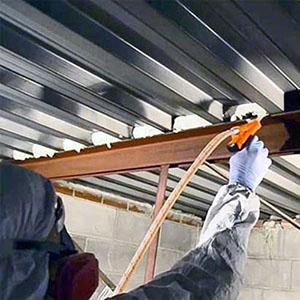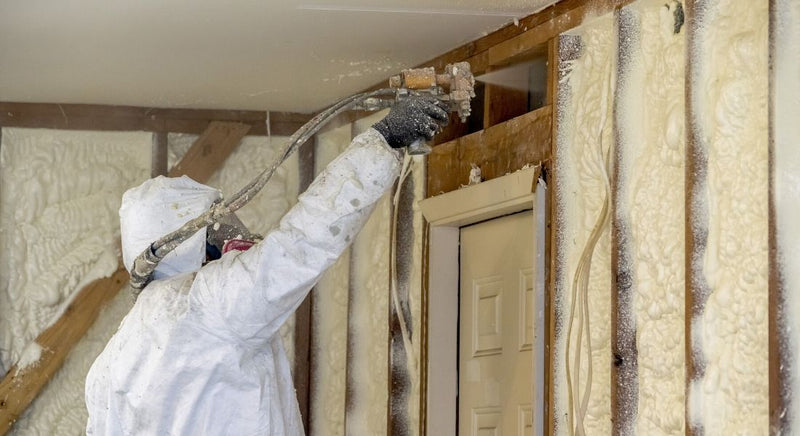How Spray Foam Can Enhance Energy Efficiency in your house
How Spray Foam Can Enhance Energy Efficiency in your house
Blog Article
Spray Foam: The Ultimate Option for Air Sealing and Insulation
Spray foam insulation has actually emerged as a leading solution for effective air securing and thermal insulation, using an unique mix of residential properties that establish it aside from conventional approaches. Its capacity to increase and load spaces makes it specifically efficient in avoiding air leakage, which can considerably influence energy effectiveness. Nonetheless, understanding the full scope of its benefits, installation processes, and comparisons with other insulation kinds is critical for making educated choices. As we discover these elements, the implications for both brand-new building and constructions and retrofits end up being significantly considerable. What factors should affect your option?
What Is Spray Foam?
Spray foam is a flexible insulation product that incorporates the concepts of air securing and thermal resistance to improve power efficiency in structures. Composed primarily of polyurethane or other comparable substances, spray foam is used as a liquid that increases upon call with surfaces, creating a solid, constant layer of insulation. This distinct building enables it to load voids, fractures, and voids that standard insulation products might neglect, offering an exceptional air seal.
There are two primary kinds of spray foam: open-cell and closed-cell. Open-cell spray foam is lighter and more adaptable, supplying superb sound absorption and a lower R-value per inch - Spray Foam. In contrast, closed-cell spray foam is denser, providing a higher R-value, dampness resistance, and included structural integrity to building elements
The application process generally entails specific equipment, making sure a seamless application that abides by different substratums, including metal, wood, and concrete. This versatility makes spray foam ideal for both brand-new constructions and retrofitting existing structures. Its capacity to create an airtight barrier considerably adds to lowering power consumption and boosting interior air high quality, consequently making it a recommended choice among home owners and builders alike.
Advantages of Spray Foam Insulation
One of the most substantial advantages of spray foam insulation is its outstanding capacity to create a constant air barrier, which properly minimizes energy loss. Unlike typical insulation materials, spray foam increases to fill up fractures and voids, making certain that air leakage is drastically reduced. This characteristic not just enhances power effectiveness yet also brings about lower utility costs in time.
Additionally, spray foam insulation offers premium thermal resistance, contributing to a much more stable interior atmosphere. Its high R-value per inch enables efficient insulation in constrained spaces, making it optimal for attic rooms, wall surfaces, and crawl areas. Moreover, the moisture-resistant properties of spray foam help stop mold and mildew and mold growth, promoting much healthier living conditions.
An additional vital benefit of spray foam insulation is its sound-dampening high qualities (Spray Foam). It efficiently decreases sound transmission between areas, developing a quieter and extra comfy home setting. The resilience of spray foam additionally sticks out, as it does not droop or resolve with time, keeping its efficiency throughout its lifespan
Just How Spray Foam Works
Understanding how spray foam insulation functions is crucial for valuing its performance in air securing and thermal resistance. Spray foam insulation contains two main components: isocyanate and polyol resin. When these elements are blended, they undergo a chain reaction that triggers the product to broaden rapidly, producing a thick foam that loads fractures, cavities, and voids.
As the foam broadens, it sticks to surfaces, creating an impermeable seal that considerably decreases air seepage. This characteristic makes spray foam insulation very efficient at preventing drafts and helpful site moisture penetration, which can cause energy loss and damages gradually. Furthermore, the closed-cell variant of spray foam offers superior thermal resistance because of its rigid framework, effectively lessening heat transfer.
The unique properties of spray foam permit it to adjust to uneven surfaces, making sure thorough protection and a seamless obstacle. Consequently, spray foam insulation not just improves power effectiveness yet additionally contributes to boosted interior air top quality by lowering the buildup of allergens and pollutants. Eventually, recognizing the auto mechanics behind spray foam emphasizes its duty as an exceptional option for insulation and air securing in both domestic and business applications.
Setup Refine Summary

Prior to setup, the room should be appropriately cleansed and prepped, making certain that surface areas are without dirt, particles, and dampness. Due to the fact that contaminants can compromise adhesion and general efficiency, this step is essential. When the location is prepared, the application entails mixing both components of the spray foam, which expands upon contact and loads voids efficiently.
Trained professionals should carry out the setup, using customized devices to make sure uniform coverage more helpful hints and optimal thickness. Security safety measures, consisting of wearing protective equipment and making sure proper air flow, are essential during this process. After application, the foam commonly cures promptly, developing a solid obstacle that enhances energy effectiveness.
Contrasting Spray Foam to Typical Insulation
When reviewing insulation choices, spray foam insulation stands apart in comparison to traditional products such as fiberglass and cellulose. One of the primary benefits of spray foam is its remarkable air securing capacities. Unlike fiberglass and cellulose, which can enable air infiltration, spray foam increases upon application, loading spaces and gaps to produce a closed seal. This leads to enhanced energy efficiency, as less warmed or cooled down air leaves the home, bring about reduced energy costs.
Additionally, spray foam gives a higher R-value per inch than conventional insulation types, providing more effective thermal resistance in a thinner account. This characteristic is specifically beneficial precede with restricted cavity deepness. Spray foam is immune to wetness and mold and mildew growth, which can be a significant issue with cellulose and fiberglass, specifically in humid environments.
Nevertheless, spray foam insulation usually lugs a greater ahead of time cost than its traditional equivalents. House owners should evaluate this initial investment against lasting energy cost savings and performance benefits. Eventually, while both insulation types serve their purpose, spray foam emerges as an advanced service for modern-day insulation needs, particularly in terms of air sealing and thermal effectiveness.

Final Thought
In recap, spray foam insulation stands for a very effective service for attaining ideal air sealing and thermal resistance. Its distinct properties, including wetness resistance and sound dampening, make it ideal for different applications in both new building and constructions and retrofitting tasks (Spray Foam). Although the first prices might be greater contrasted to conventional insulation materials, the lasting click for info advantages, such as significant power savings and boosted indoor air high quality, justify the financial investment and highlight its value in modern-day building practices.
Spray foam insulation has arised as a leading service for efficient air securing and thermal insulation, offering an unique mix of residential properties that set it apart from conventional methods.Spray foam is a flexible insulation product that integrates the principles of air securing and thermal resistance to improve power efficiency in buildings.When reviewing insulation choices, spray foam insulation stands out in contrast to standard materials such as fiberglass and cellulose. Eventually, while both insulation types offer their purpose, spray foam emerges as an extra advanced service for contemporary insulation requirements, specifically in terms of air securing and thermal efficiency.
In recap, spray foam insulation represents an extremely effective remedy for achieving optimum air sealing and thermal resistance.
Report this page